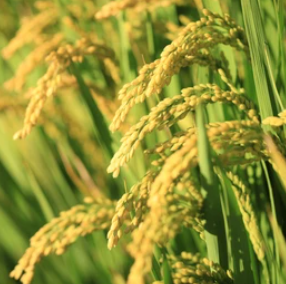Information report for PLA1
Gene Details
|

|
Functional Descriptions
- PLA1 of rice is not only a plastochron mutant showing rapid leaf initiation without affecting phyllotaxy, but also a heterochronic mutant showing ectopic shoot formation in the reproductive phase.
- On the basis of these findings, we propose that NL1 is an intrinsic factor that modulates and coordinates organogenesis through regulating the expression of PLA1 and other regulatory genes during reproductive development in rice.
- The shoot apical meristem of PLA1 was larger than that of the wild type, although the shape was not modified.
- An in situ hybridization experiment using the histone H4 gene as a probe revealed that cell divisions are accelerated in the PLA1 meristem.
- The PLA1 gene is considered to regulate the duration of the vegetative phase by controlling the rate of leaf production in the meristem.
- PLA1 is expressed in developing leaf primordia, bracts of the panicle, and elongating internodes, but not in the shoot apical meristem.
- These results indicate that both PLA1 and PLA2 act downstream of the GA signal transduction pathway to regulate leaf development.
- Because the onset of the reproductive phase in PLA1 was not temporally affected, the number of leaves produced in the vegetative phase was nearly twice that produced in the wild type.
- These results indicate that both vegetative and reproductive programs are expressed simultaneously during the reproductive phase of PLA1; however, the degree varied depending on the strength of the allele.
- Thus, PLA1 provides a tool for analyzing the molecular basis of temporal regulation in leaf development.
- pla3 exhibits similar phenotypes to PLA1 and pla2- a shortened plastochron, precocious leaf maturation and rachis branch-to-shoot conversion in the reproductive phase.
- Panicle development was severely disturbed in PLA1 mutants.
- In the weak allele PLA1-2, however, only the basal one or two primordia developed as vegetative shoots, and the remaining primordia developed to produce a truncated panicle.
- However, in contrast to PLA1 and pla2, pla3 showed pleiotropic phenotypes including enlarged embryo, seed vivipary, defects in SAM maintenance and aberrant leaf morphology.
- Rice PLASTOCHRON 1 (PLA1) and PLA2 genes regulate leaf maturation and plastochron, and their loss-of-function mutants exhibit small organs and rapid leaf emergence.
- GA induced PLA1 and PLA2 expression, and conversely the GA-inhibitor uniconazole suppressed PLA1 and PLA2 expression.
- In PLA1-4 and pla2-1 seedlings, expression levels of GA biosynthesis genes and the signal transduction gene were similar to those in wild-type seedlings.
- GA treatment slightly down-regulated the GA biosynthesis gene GA20ox2 and up-regulated the GA-catabolizing gene GA2ox4, whereas the GA biosynthesis inhibitor uniconazole up-regulated GA20ox2 and down-regulated GA2ox4 both in wild-type and pla mutants, suggesting that the GA feedback mechanism is not impaired in PLA1 and pla2.
- To reveal how GA signal transduction affects the expression of PLA1 and PLA2, PLA expression in GA-signaling mutants was examined.
- In PLA1-1, many primordia of primary rachis branches were converted into vegetative shoots.
- Accordingly, PLA1 is a heterochronic mutation that extends the vegetative period.
- The expression pattern and mutant phenotype suggest that the PLA1 gene acting in developing leaf primordia affects the timing of successive leaf initiation and the termination of vegetative growth.
- A novel mutant allele of PLASTOCHRON1 (PLA1), a gene known to play a key role in regulating leaf initiation, was identified in this study.
- We found that gibberellin (GA) is the major phytohormone that promotes PLA1 and PLA2 expression.
- Here, we investigated how PLA1 and PLA2 genes are related to phytohormones.
- We show that PLA2 normally acts to retard the rate of leaf maturation but does so independently of PLA1, which encodes a member of the P450 family.
Functional Keywords
- reproductive , meristem , shoot , leaf-development , shoot-apical-meristem , panicle , leaf , ga , vegetative , seedling , growth , cell-division , gibberellin , phytohormone , seed
Literature and News
- Rice PLASTOCHRON genes regulate leaf maturation downstream of the gibberellin signal transduction pathway . DOI: 10.1007/s00425-012-1639-5 ; PMID: 22476293
- NECK LEAF 1, a GATA type transcription factor, modulates organogenesis by regulating the expression of multiple regulatory genes during reproductive development in rice . DOI: 10.1038/cr.2009.36 ; PMID: 19337211
- PLASTOCHRON3/GOLIATH encodes a glutamate carboxypeptidase required for proper development in rice . DOI: 10.1111/j.1365-313X.2009.03841.x ; PMID: 19228340
- A recessive heterochronic mutation, plastochron1, shortens the plastochron and elongates the vegetative phase in rice . DOI: 10.1105/tpc.10.9.1511 ; PMID: 9724697
- PLASTOCHRON1, a timekeeper of leaf initiation in rice, encodes cytochrome P450 . DOI: 10.1073/pnas.2636936100 ; PMID: 14711998
- PLASTOCHRON2 regulates leaf initiation and maturation in rice . DOI: 10.1105/tpc.105.037622 ; PMID: 16461585
- Jasmonate regulates juvenile-to-adult phase transition in rice . DOI: 10.1242/dev.138602 ; PMID: 27578792
Gene Resources
- UniProt: Q7Y1V5
- EMBL: AB096259, AC083943, AP008216
- AlphaFoldDB: Q7Y1V5
- EnsemblPlants: Os10t0403000-01
- Gramene: Os10t0403000-01
- KEGG: dosa:Os10g0403000
- Orthologous matrix: RRFAMTT
- InterPro: IPR001128, IPR002401, IPR017972
- PANTHER: PTHR47946, PTHR47946:SF6
- SUPFAM: SSF48264
- PROSITE: PS00086
- Gene3D: 1.10.630.10
- OrthoDB: Q7Y1V5
- SWISS-MODEL: Q7Y1V5
- Conserved Domain Database: cd11076
- eggNOG: KOG0156
Homologs
- Brassica napus: BnaA9.CYP78A9, BnaA09G0639400ZS, BnaC08G0496800ZS
- Brassica oleracea: Bo8g107290
- Brassica rapa: Bra026892
- Citrullus lanatus: Cla97C08G153350
- Cucumis melo: MELO3C011413
- Glycine max: Glyma.19G240800
- Gossypium hirsutum: Gohir.D13G083200, Gohir.A13G083300, Gohir.A12G160500, Gohir.D12G163800, Gohir.D02G130000
- Musa acuminata: Ma06_g36880, Ma09_g27340
Sequences
cDNA Sequence
- >LOC_Os10g26340.1
ATGGCAATGGCCACCGCCACCGCCTCCTCCTGCGTCGACGCCACGTGGTGGGCGTACGCCCTCCCGGCGCTCCTCGGCGCCGACACCCTCTGCGCCCACCCGGCGCTGCTCGCCGGCGCCGTCCTCCTGGCCTTCGCCACCGCCGCGGTGCTCGCCTGGGCCGCGTCCCCCGGCGGGCCGGCGTGGGCGCACGGCCGCGGCCGCCTCGGCGCGACGCCCATCGAGGGGCCCCGGGGGCTCCCCGTGTTCGGCAGCATCTTCGCGCTCTCCCGGGGCCTCCCGCACCGCGCGCTCGACGCGATGTCGCGCGACGCGGCGGCGCCACGGGCGAGGGAGCTCATGGCGTTCTCCGTCGGGGAGACGCCGGCGGTGGTGTCGTCGTGCCCGGCGACGGCGAGGGAGGTGCTCGCGCACCCGTCGTTCGCCGACCGCCCGCTGAAGCGCTCGGCGCGGGAGCTGCTGTTCGCGCGCGCCATCGGGTTCGCCCCCAGCGGCGAGTACTGGCGCCTCCTCCGCCGCATCGCCTCCACCCACCTCTTCTCCCCTCGCCGCGTCGCCGCGCACGAGCCGGGGCGCCAGGCCGACGCCACGGCGATGCTGTCCGCCATGGCCGCCGAGCAGTCCGCCACCGGCGCCGTCGTGCTCCGCCCCCACCTCCAGGCCGCCGCGCTCAACAACATCATGGGCAGCGTGTTCGGCCGGCGCTACGACGTCTCCTCCTCCTCCGGCGCCGCCGCCGACGAGGCCGAGCAGCTCAAGAGCATGGTGCGCGAGGGGTTCGAGCTCCTCGGCGCGTTCAACTGGTCCGACCACCTCCCATGGCTCGCCCACCTCTACGACCCCAACCACGTCGCCCGCCGCTGCGCCGCGCTCGTCCCCCGCGTCCAGGCGTTCGTCCGCGGCGTCATCCGCGACCACCGCCTCCGCCGCGACTCCTCCTCCACCGCCGCCGACAATGCCGACTTCGTCGACGTCCTCCTCTCCCTCGAGGCCCACGAGAACCTCGCCGAGGACGACATGGTCGCCGTCCTCTGGGAGATGATATTTCGTGGGACGGACACGACGGCGTTGGTGACGGAGTGGTGCATGGCGGAGGTGGTGAGGAACCCGGCGGTGCAGGCGAGGCTGAGGGCGGAGGTGGACGCGGCGGTGGGCGGCGACGGGTGTCCCAGCGACGGCGACGTGGCGCGGATGCCGTACCTGCAGGCGGTGGTGAAGGAGACGCTGAGGGCGCACCCGCCGGGGCCGCTGCTGAGCTGGGCGCGGCTGGCCACCGCCGACGTGGGGCTCGCCAACGGCATGGTGGTGCCGGCGGGCACGACGGCGATGGTGAACATGTGGGCCATCACCCACGACGGCGAGGTGTGGGCCGACCCGGAGGCGTTCGCGCCGGAGCGGTTCATCCCGTCGGAGGGCGGCGCCGACGTCGACGTCCGCGGCGGCGACCTCCGCCTGGCGCCGTTCGGCGCCGGGCGCCGCGTCTGCCCCGGCAAGAACCTCGGCCTCGCCACCGTCACCCTCTGGGTCGCCCGCCTCGTCCACGCCTTCGACTGGTTCCTCCCCGACGGCTCGCCGCCGGTGTCCCTCGACGAGGTCCTCAAGCTCTCCCTCGAGATGAAGACCCCTCTCGCCGCCGCCGCCACCCCCCGCCGCCGCCGCGCCGCCTGA
CDS Sequence
- >LOC_Os10g26340.1
ATGGCAATGGCCACCGCCACCGCCTCCTCCTGCGTCGACGCCACGTGGTGGGCGTACGCCCTCCCGGCGCTCCTCGGCGCCGACACCCTCTGCGCCCACCCGGCGCTGCTCGCCGGCGCCGTCCTCCTGGCCTTCGCCACCGCCGCGGTGCTCGCCTGGGCCGCGTCCCCCGGCGGGCCGGCGTGGGCGCACGGCCGCGGCCGCCTCGGCGCGACGCCCATCGAGGGGCCCCGGGGGCTCCCCGTGTTCGGCAGCATCTTCGCGCTCTCCCGGGGCCTCCCGCACCGCGCGCTCGACGCGATGTCGCGCGACGCGGCGGCGCCACGGGCGAGGGAGCTCATGGCGTTCTCCGTCGGGGAGACGCCGGCGGTGGTGTCGTCGTGCCCGGCGACGGCGAGGGAGGTGCTCGCGCACCCGTCGTTCGCCGACCGCCCGCTGAAGCGCTCGGCGCGGGAGCTGCTGTTCGCGCGCGCCATCGGGTTCGCCCCCAGCGGCGAGTACTGGCGCCTCCTCCGCCGCATCGCCTCCACCCACCTCTTCTCCCCTCGCCGCGTCGCCGCGCACGAGCCGGGGCGCCAGGCCGACGCCACGGCGATGCTGTCCGCCATGGCCGCCGAGCAGTCCGCCACCGGCGCCGTCGTGCTCCGCCCCCACCTCCAGGCCGCCGCGCTCAACAACATCATGGGCAGCGTGTTCGGCCGGCGCTACGACGTCTCCTCCTCCTCCGGCGCCGCCGCCGACGAGGCCGAGCAGCTCAAGAGCATGGTGCGCGAGGGGTTCGAGCTCCTCGGCGCGTTCAACTGGTCCGACCACCTCCCATGGCTCGCCCACCTCTACGACCCCAACCACGTCGCCCGCCGCTGCGCCGCGCTCGTCCCCCGCGTCCAGGCGTTCGTCCGCGGCGTCATCCGCGACCACCGCCTCCGCCGCGACTCCTCCTCCACCGCCGCCGACAATGCCGACTTCGTCGACGTCCTCCTCTCCCTCGAGGCCCACGAGAACCTCGCCGAGGACGACATGGTCGCCGTCCTCTGGGAGATGATATTTCGTGGGACGGACACGACGGCGTTGGTGACGGAGTGGTGCATGGCGGAGGTGGTGAGGAACCCGGCGGTGCAGGCGAGGCTGAGGGCGGAGGTGGACGCGGCGGTGGGCGGCGACGGGTGTCCCAGCGACGGCGACGTGGCGCGGATGCCGTACCTGCAGGCGGTGGTGAAGGAGACGCTGAGGGCGCACCCGCCGGGGCCGCTGCTGAGCTGGGCGCGGCTGGCCACCGCCGACGTGGGGCTCGCCAACGGCATGGTGGTGCCGGCGGGCACGACGGCGATGGTGAACATGTGGGCCATCACCCACGACGGCGAGGTGTGGGCCGACCCGGAGGCGTTCGCGCCGGAGCGGTTCATCCCGTCGGAGGGCGGCGCCGACGTCGACGTCCGCGGCGGCGACCTCCGCCTGGCGCCGTTCGGCGCCGGGCGCCGCGTCTGCCCCGGCAAGAACCTCGGCCTCGCCACCGTCACCCTCTGGGTCGCCCGCCTCGTCCACGCCTTCGACTGGTTCCTCCCCGACGGCTCGCCGCCGGTGTCCCTCGACGAGGTCCTCAAGCTCTCCCTCGAGATGAAGACCCCTCTCGCCGCCGCCGCCACCCCCCGCCGCCGCCGCGCCGCCTGA
Protein Sequence
- >LOC_Os10g26340.1
MAMATATASSCVDATWWAYALPALLGADTLCAHPALLAGAVLLAFATAAVLAWAASPGGPAWAHGRGRLGATPIEGPRGLPVFGSIFALSRGLPHRALDAMSRDAAAPRARELMAFSVGETPAVVSSCPATAREVLAHPSFADRPLKRSARELLFARAIGFAPSGEYWRLLRRIASTHLFSPRRVAAHEPGRQADATAMLSAMAAEQSATGAVVLRPHLQAAALNNIMGSVFGRRYDVSSSSGAAADEAEQLKSMVREGFELLGAFNWSDHLPWLAHLYDPNHVARRCAALVPRVQAFVRGVIRDHRLRRDSSSTAADNADFVDVLLSLEAHENLAEDDMVAVLWEMIFRGTDTTALVTEWCMAEVVRNPAVQARLRAEVDAAVGGDGCPSDGDVARMPYLQAVVKETLRAHPPGPLLSWARLATADVGLANGMVVPAGTTAMVNMWAITHDGEVWADPEAFAPERFIPSEGGADVDVRGGDLRLAPFGAGRRVCPGKNLGLATVTLWVARLVHAFDWFLPDGSPPVSLDEVLKLSLEMKTPLAAAATPRRRRAA*